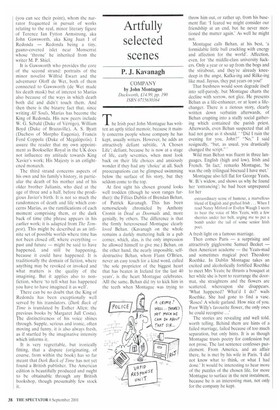Three strands intertwined
John de Falbe
DARK BACK OF TIME by Javier Marias New Directions, I:19.75, pp. 336 ISBN 0811214664 Although Javier Marfas has sold nearly two million books in Europe, he is not widely known in Britain despite two of his books being rooted in English literature. His first novel to be published in English was All Souls, in 1992. It is set in Oxford, where the unnamed Spanish narrator occupies an academic position held at that time by Marias. This is not the only circumstance that caused it to be regarded by some as a roman a clef. Since then, there have been A Heart So White (which won the prestigious Dublin IMPAC award), Tomorrow in the Battle Think on Me, and When I Was Mortal, a collection of stories. In each of these, the reader is obliged to wonder about the relation between the fiction and the author's own life.
Given his preoccupations, it must have been exhilarating, indeed spooky, for Marfas to find the fictional world of All Souls claiming space in his real life. His new book, Dark Back of Time, which he describes as a 'false novel', appears to be an account of what happened. But at its heart is an astonishing meditation on identity and time. There is no linear narrative but rather three strands, each one derived from his own and other people's memories and writings, which are woven together in such a way that images and ideas resonate with wonderful and beautiful clarity. It is his unique style —witty and mesmerising, reminiscent of Proust or Sterne (no accident: he translated Sterne into Spanish) — that makes the passage between truth and fiction fluid and convincing.
The first strand comes from the roman a clef aspect of All Souls. While allowing that some fictional elements were borrowed from real life, Marias insists that identifications are misplaced and goes on to describe in hilarious detail how the opposite has also occurred: there are real people who have taken on characteristics from their imagined fictional counterparts. Among these are the Stones, real booksellers who believe they are the booksellers in All Souls named Alabaster (you can see their point), whom the narrator frequented in pursuit of works relating to the real, minor literary figure of Terence Ian Fytton Armstrong, aka John Gawsworth, aka King Juan I of Redonda — Redonda being a tiny, guano-covered islet near Monserrat whose 'throne' he inherited from the writer M. P. Shiel.
It is Gawsworth who provides the core of the second strand: portraits of the minor novelist Wilfrid Ewart and the adventurer Oloff de Wet, both of them connected to Gawsworth (de Wet made his death mask) but of interest to Marias also because of the ways in which death both did and didn't touch them. And then there is the bizarre fact that, since writing All Souls, Marias has become the King of Redonda. His new peers include W. G. Sebald (Duke of Vertigo), William Boyd (Duke of Brazaville), A. S. Byatt (Duchess of Morpho Eugenia), Francis Ford Coppola (Duke of Megalopolis). I assure the reader that my own appointment as Bookseller Royal in the UK does not influence my attitude towards King Xavier's work; His Majesty is an enlightened monarch.
The third strand concerns aspects of his own and his family's history, in particular the death of his mother and of his older brother Julianin, who died at the age of three and a half, before the prodigious Javier's birth. It is not so much the randomness of death and life which concerns Marias, as the ramifications of each moment comprising them, or the dark back of time (the phrase appears in his earlier work; it is adapted from The Tempest). This might be described as an infinite set of possible worlds where time has not been closed off, where everything — past and future — might be said to have happened, and still be happening, because it could have happened. It is traditionally the domain of fiction, where anything may be revoked or invoked and what matters is the quality of the imagining. But it applies also to nonfiction, where `to tell what has happened you have to have imagined it as well'.
There can be no doubt that the King of Redonda has been exceptionally well served by his translators. (Dark Back of Time is translated by Esther Allen; the previous books by Margaret kill Costa). The distinctiveness of his voice shines through. Supple, serious and ironic, often moving and funny, it is also always fresh, as if startled by the imaginative intensity which informs it.
It is very regrettable, but ironically fitting, that a dispute (originating, of course, from within the book) has so far meant that Dark Back of Time has not yet found a British publisher. The American edition is beautifully produced and ought to be obtainable through any British bookshop, though presumably few stock it.



































































 Previous page
Previous page